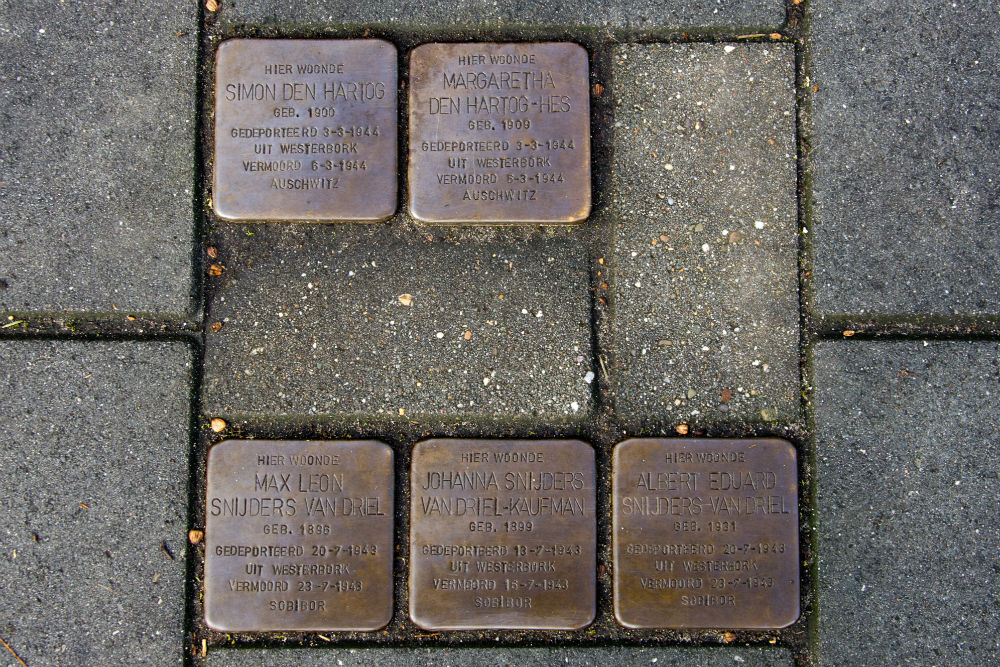Stumbling Stones Kruisstraat 89
Stolpersteine / Stumbling Stones commemorate:
* Simon den Hartog, born 1900, deported 3 March 1944 from Westerbork, murdered 6 March 1944 Auschwitz.
* Margaretha den Hartog-Hes, born 1909, deported 3 March 1944 from Westerbork, murdered 6 March 1944 Auschwitz.
* Max Leon Snijders van Driel, born 1886, deported 20 July 1943 from Westerbork, murdered 23 July 1943 Sobibor.
* Johanna Snijders van Driel-Kaufman, born 1899, deported 13 July 1943 from Westerbork, murdered 16 July 1943 Sobibor.
* Albert Eduard Snijders van Driel, born 1931, deported 20 July 1943 from Westerbork, murdered 23 July 1943 Sobibor.
Simon den Hartog, an administrative assistant, married Margaretha Hes. They were killed on the same day in Sobibor. Their two sons -- Benno Nico (b.1932) and Eddy (b.1937) -- survived.
Simonís parents were murdered at Sobibor on 9 July 1943: Carolina den Hartog-Braadbaart and Benjamin den Hartog. Their other son who lived with them, Philip Nathan den Hartog, was killed in Central Europe in 1944. Stolpersteine for the three are at Bankastraat 9. Simonís two sisters survived; both died later in Israel.
Stolpersteine for Margarethaís father, sister and step-mother are at Hermanslaan 6 in Oss.
Max Leon Snijders van Driel, a sales representative and Johanna Kaufman married and had a son, Albert Eduard, who was 11 when he was murdered.
Max Leon Snijders van Driel had one sibling -- Jeannette Frederika Snijders van Driel; she married Frits Spanjaard civil engineer (1903-1943) but information on their deaths was not seen.
Regarding Johannaís birth family, of the 8 Kaufman adult children alive at the beginning of the war, only one survived the Holocaust.
"Stolpersteine" is an art project for Europe by Gunter Demnig to commemorate victims of National Socialism (Nazism). Stolpersteine (stumbling stones) are small, 10x10cm brass plaques placed in the pavement in front of the last voluntary residence of (mostly Jewish) victims who were murdered by the Nazis. Each plaque is engraved with the victimís name, date of birth and place (mostly a concentration camp) and date of death. By doing this, Gunter Demnig gives an individual memorial to each victim. One stone, one name, one person. He cites the Talmud: "A human being is forgotten only when his or her name is forgotten."
Borne was the first town in the Netherlands in which Stolpersteine were placed --on 29 November 2007.
Do you have more information about this location? Inform us!
Source
- Text: Anne Palmer
- Photos: Peter Mulder
- Joods Monument
- Geni.com
- Stolpersteine.eu
Nearby
Point of interest
Monument
- War Memorial Town Hall Oss - Oss
- Monument Titus Brandsma Oss - Oss
- Memorial Killed NS Employee - Oss
Cemetery
- Grave Civilian Casualty Roman Catholic Cemetery Oss - Oss
- Commonwealth War Graves Roman Catholic Cemetery Heesch - Heesch
- Dutch War Grave Roman Catholic Cemetery Heesch - Heesch
Remembrance Stone
- Stumbling Stones Kromstraat 2 - Oss
- Stumbling Stones Kortfoortstraat 195 (now opp. Kortfoortstraat 124) - Oss
- Stumbling Stone Katwijkstraat 24 - Oss





